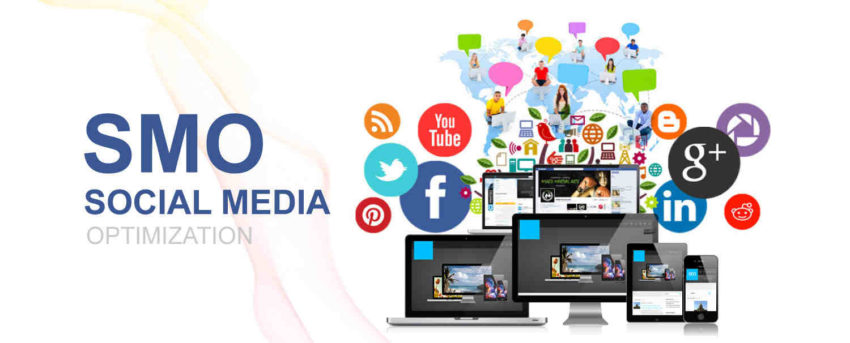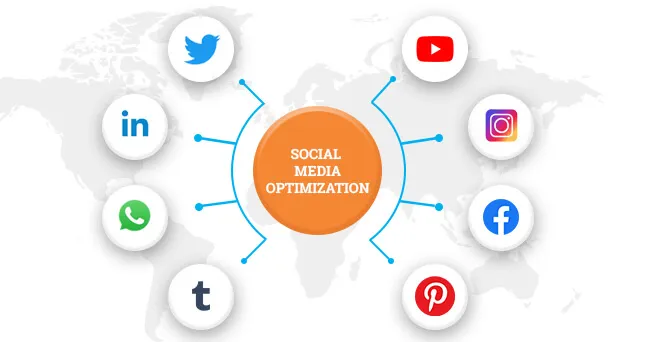What is Social Media Optimization (SMO) and Why it is Important

The Social media optimization (SMO) is the process of optimizing your social media profiles and content to increase visibility, engagement, and reach. As a digital marketing strategy, social media optimization can be used to increase awareness of new products and services, connect with customers, and mitigate potentially damaging news.
Social media optimization is the use of social media sites to enhance a company or organization’s brand and its online presence. Their are many Social media sites that have been used to increase awareness of new products and services and help organizations connect with customers.
Why Social Media Optimization (SMO) is Important
Social Media Optimization (SMO) is Important in several ways:
1) Social media optimization helps to improve the visibility of your brand, products, and content on social media platforms.
2) Optimizing your social media presence encourages higher levels of engagement with your audience.
3) It plays a crucial role in building brand awareness and recognition.
4) A well-optimized social media presence helps build trust and credibility with your audience.
5) SMO can contribute to lead generation and sales for your business.
Social Media Optimization (SMO) Tips
Define Your Goals:
Clearly define your objectives for social media optimization. Whether it’s increasing brand awareness, driving website traffic, or generating leads, having specific goals will guide your SMO strategy. Your SMO goals should align with your broader business objectives. Consider how your social media efforts can contribute to overarching goals such as revenue growth, customer acquisition, or brand loyalty.
If you have multiple objectives, prioritize them based on their importance to your business and the resources required to achieve them. Focus on the goals that will have the most significant impact on your bottom line or long-term success.
Optimize Your Social Media Profiles:
Ensure that your social media profiles are complete, consistent, and branded. Use high-quality images for profile pictures and cover photos, and include relevant keywords in your bio and description. Choose an eye-catching cover photo that reflects your brand’s personality and values. This could be a branded image, a showcase of your products or services, or a visually appealing background related to your industry.
Make it easy for people to get in touch with you by including your contact information in your profile.
It includes your email address, phone number, website URL, or links to other social media profiles. Double-check that all contact information is accurate and up-to-date. Regularly review and update your social media profiles to keep them fresh and relevant. Update your bio, cover photo, and other details as needed to reflect any changes in your brand or business.
Know Your Audience:
Understand your target audience’s demographics, interests, and behaviors. Tailor your content and messaging to resonate with your audience and address their needs and preferences. Engage in conversations with your audience on social media to gain deeper insights into their preferences and interests. Ask questions, run polls, and encourage feedback to foster two-way communication.
And build relationships with your audience. Pay close attention to how your audience interacts with your content on social media. Monitor comments, likes, shares, and direct messages to understand what resonates with them and what doesn’t.
Create Engaging Content:
Just create Engaging content for your social media profiles to reach out to your loyal audience. Produce high-quality, relevant, and engaging content that adds value to your audience. And Mix up your content formats (e.g., images, videos, infographics) and do experiment with different types of posts to keep your audience interested.
Share personal lifestyle, customer testimonials, success stories, or behind-the-scenes glimpses to connect with your social media audience on an emotional level. Share some valuable and informative content that helps your audience to learn something new or solve a problem. Create how-to guides, tutorials, tips and tricks, or industry insights that demonstrate your expertise and provide practical value to your audience.
Use Relevant Hashtags:
Using relevant hashtags is an effective way to increase the discoverability of your content on social media platforms. Use tools like Hashtagify, RiteTag, or social media analytics to discover trending and relevant hashtags. Use of Branded hashtags can help you to increase brand visibility, encourage user-generated content, and foster community engagement around your brand.
Choose hashtags that are specific and relevant to the content of your post. Use a moderate number of hashtags in your posts to avoid coming across as spammy or overwhelming. Develop hashtag campaigns around specific themes, events, or promotions to encourage user participation and engagement. And Promote your campaign hashtags across your social media channels and encourage your audience to join the conversation.
Encourage Audience Engagement:
Encouraging engagement is key to building a vibrant and interactive community around your brand on social media. So, Conduct polls and surveys to gather feedback from your social media audience and involve them in decision-making processes. Encourage your followers to create and share content related to your brand or products. Highlight customer success stories, testimonials, and reviews to showcase the impact of your products or services. So, Tag and thank customers for their contributions to foster a sense of community and loyalty.
Reward engagement with incentives such as exclusive discounts, giveaways, or access to premium content. And It Offer glimpses behind the scenes of your business, such as sneak peeks of product development, office tours, or team highlights. Authentic and transparent content humanizes your brand and strengthens the bond with your audience.
Monitor and Analyze Performance:
Regularly monitor your social media analytics to track key metrics such as engagement, reach, clicks, and conversions. Use these insights to assess the effectiveness of your SMO efforts and make data-driven decisions. Monitor metrics related to engagement, such as likes, comments, shares, retweets, mentions, and replies. Monitor your social media performance against competitors and industry benchmarks. And Gain insights into competitor strategies, audience preferences, and emerging trends to inform your own strategy.
Identify the key performance indicators (KPIs) that align with your goals and objectives. These may include metrics such as engagement rate, reach, impressions, clicks, conversions, follower growth, and social media ROI. Experiment with different approaches, content types, posting times, and targeting strategies to continually improve performance and achieve your objectives.
Understanding of Social Media Optimization (SMO)

SMO is one of the leading Digital Marketing Strategies of the Social Media world. The SMO primarily focuses on attracting web visitors from sources other than search engines. SMO allows SMM (social media marketing) initiatives to operate better by improving content, similar to how SEO supports higher search engine rankings. It may also implement online reputation management (ORM). If someone submits unfavorable reviews about a firm, an SMO strategy can ensure that the negative reviews are not the first link to show in a search engine.
Social media platforms allow users to share content on the internet almost instantaneously. Because of this, many companies try to create content that users will pass along to their friends and connections. And this strategy, called viral marketing, attempts to achieve a broader reach by getting engaged users of social media platforms to share content rather than relying on users to find the content on their own.
Social Media Optimization on Facebook:
Optimizing your presence on Facebook is crucial for maximizing your reach, engagement, and impact on the platform. It’s a great way to stay connected with your customers, and you have the options to increase awareness by boosting posts or using Facebook ads.
Some Strategy for Social Media Optimization on Facebook
1) Ensure that your Facebook Page is fully optimized with all relevant information, including your profile picture, cover photo, about section, contact details, and website link.
2) Maintain consistent branding across your Facebook Page by using the same logo, color scheme, and tone of voice as your other online channels.
3) Share high-quality, relevant content that adds value to your audience.
4) Use Facebook Insights to analyze when your followers are most active and adjust your posting schedule accordingly.
5) And Utilize Facebook Insights to track key metrics such as reach, engagement, and page likes.
Free Facebook Optimization Tools:
- Facebook Ads Performance Grader to audit and optimize your paid ads.
- iconosquare instant Facebook Business Page audit.
- DrumUp to help you curate and share content fit for your audience.
- Comment Picker to pick your Facebook contest winners at random.
Social Media Optimization on YouTube:
Social media optimization (SMO) on YouTube involves optimizing your channel and video content to increase visibility, engagement, and audience growth on the platform. It may seem daunting to get into the video marketing space, but it’s been an increasingly important way to communicate with your potential and current customers. And think about traditional TV commercials for a minute. Those still cost a LOT of money! For basically free, you can make your own video from your phone and upload it to YouTube.
It’s also a great way to embed some great content on your website and not slow it down!
Some Strategy for Social Media Optimization on YouTube
Optimizing your presence on Facebook involves several strategic approaches. To increase engagement, reach, and ultimately, achieve your goals, whether they’re driving traffic, generating leads, or building brand awareness.
- So, Create posts that connect with your audience, such as informative articles, entertaining videos, eye-catching images, and interactive polls/questions.
- Utilize Facebook Insights to understand your audience demographics, behaviors, and preferences.
- And Use high-quality images, videos, infographics, and GIFs to capture your audience’s attention as they scroll through their feed.
- Encourage participants to like, comment, and share your posts to gain entries.
- Regularly review your Facebook Insights to track the performance of your posts.
Free YouTube Optimization Tools:
- TubeRanker for a channel audit
- VidlQ to measure tags, watch time, and shares
- TubeBuddy to manage your channel
- Kparser for YouTube keyword research
- Punchbug’s YouTube video optimization checklist



